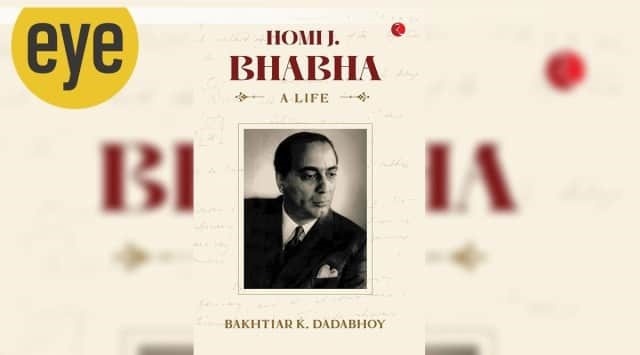Bakhtiar Dadabhoy’s Homi J Bhabha: A Life chronicles not only the life of an exceptional scientist, but an important era in Indian science
The biography of Bhabha, who established India’s nuclear energy programme, covers a vast canvas — his early life, scientific experiments, institution building, his role as a science administrator and a patron of the arts.
Article by Arun Kumar Grover | Indian Express
Homi J Bhabha: A Life, Bakhtiar Dadabhoy, Rupa, 776 pages, Rs 995. (Source: Amazon.in)
Homi J. Bhabha: A Life is the first comprehensive full-length account of India’s most impactful scientist-administrator. The author, Bakhtiar Dadabhoy, has also written a bestselling biography of JRD Tata and the authorised biography of music conductor Zubin Mehta.
Bhabha not only conceived of and established India’s nuclear energy programme but also laid the foundations for India’s electronics industry, apart from nurturing Vikram Sarabhai’s space programme under the umbrella of the Department of Atomic Energy. In 1941, CV Raman had introduced the 32-year-old Bhabha as the modern equivalent of Leonardo da Vinci at the annual meeting of the Science Academy founded by him. At Bhabha’s Birth Centenary Symposium in 2009, CNR Rao wanted the Bharat Ratna to be awarded to Bhabha posthumously, which, alas, did not happen.
There have been a few books on Bhabha in the past, all with undeniable merit. Of these, condensed-matter physicist G Venkataraman’s largely hagiographic account Bhabha and his Magnificent Obsessions (1994) is perhaps the best known. Dadabhoy’s biography parallels Venkataraman’s other work, Journey into Light, about Raman. This biography of Bhabha covers a vast canvas — his early life, scientific experiments, institution building, his role as a science administrator, a patron of art and culture and much more. This is, as Dadabhoy tells us, as much an early history of both Tata Institute of Fundamental Research and the atomic energy programme, as an account of Bhabha’s life.
It is a sad reflection on the galaxy of eminent science leaders nurtured by Bhabha that none of them felt compelled to write a complete biography of their mentor. The present book succeeds admirably in placing most of the important facts about Bhabha before the reader, having drawn extensively from primary and secondary sources which have been listed in more than 100 pages. The objective and neutral tone of Dadabhoy’s narrative prevents it from becoming yet another hagiographic account.
For example, Dadabhoy describes in detail Bhabha’s strained relationship with DD Kosambi and recounts the somewhat unhappy relationship he shared with Piara Singh Gill, a cosmic-ray physicist. His assessment of Bhabha as a person, ‘warts and all’, is a refreshing change. Bhabha’s successors at TIFR and Atomic Energy Commission held him in too much awe for an objective assessment.
Filled with delightful anecdotes and engaging prose, this biography also reconstructs the background of the then-scientific world in the first chapter, ‘Before Homi Bhabha’, in which we encounter luminaries from the world of Indian science: Mahendra Lal Sircar, Jagadish Chandra Bose, Sir Asutosh Mookerjee, Meghnad Saha, SN Bose, Shanti Swarup Bhatnagar, and Raman. Bhabha was close to the physicist KS Krishnan and the falling out between Krishnan and Raman is part of the story – including the disappearance of Krishnan’s original diary (which was a daily record of events leading up to the Raman effect’s discovery). Later, Dadabhoy narrates how Bhabha sent the mathematician Harish-Chandra to study under Paul Dirac. (About two decades ago, this reviewer had a role in raising money for instituting the Harish-Chandra Best PhD thesis Award in mathematics at TIFR. His wife, Lily, and daughter, Premi, both made contributions.)
Broadly divided into three distinct parts — ‘Scientist as Researcher’, ‘Scientist as Institution-Builder’ and ‘Scientist as Administrator’ — this monumental study consisting of 36 chapters also draws the readers’ attention to Bhabha’s Parsi lineage, his brilliance as an artist, his love of music, and later his patronage of the arts. An early advocate of afforestation, it was Bhabha who pioneered the transplantation of full-grown trees. He also had his own terrace garden.
Bhabha also made available a new salary structure for scientists on par with bureaucrats as early as the 1960s. A professor at TIFR drew the salary of a joint secretary to the Government of India. Director, TIFR and director, BARC were assigned a salary grade equivalent to that of the chairman, AEC, i.e., a secretary to the Government of India. Professors in the IITs had to wait till the Fifth Pay Commission in 1996 to get a grade comparable to that of a joint secretary.
The excellent photographs in the book are an icing on the cake. At 750-plus pages, the size of the book may deter readers, but those who persevere will be amply rewarded. There is scope to add more to a new edition of the book. Dadabhoy has not accessed some interesting Bhabha documents which were unearthed in the run up to Bhabha’s birth centenary in 2009. However, the author deserves to be congratulated for having performed a much-needed service by chronicling in detail not only the life of an exceptional man, but an important era in Indian science.
Also Read(Arun Kumar Grover is a physicist and a former vice chancellor of Panjab University)

